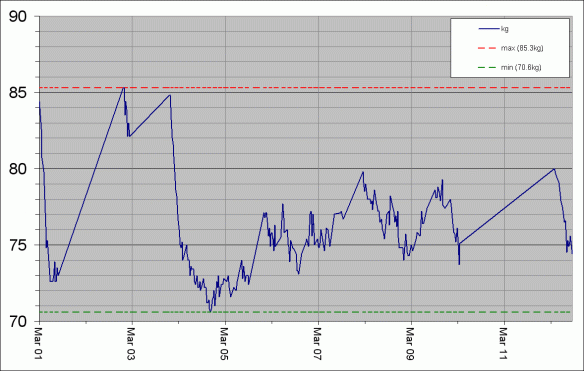I first came across the Stillman running weight formula sometime in 2012 although I can no longer find the particularly thorough article in which I first read about it. The formula presumably comes from the pre internet age as I can only find it referred to indirectly online and even then some articles* appear to have been published offline before appearing online.
The formula reflects the simple observation that elite runners are typically lighter than non-runners (of healthy weight) and that as the event distance increases so the athlete tends to be proportionally even lighter. Whether there was any physiological justification of the formula is not clear from the articles I’ve seen; it may be that Dr Stillman derived the formula mathematically to best model the weight of elite runners at the various event distances. I’m writing about the formula not to prescribe a particular running weight as “right”, but purely because I’ve used it to set a personal running weight goal and found using it interesting.
The formula uses imperial units for both weight and height and though I’ve seen the formula re-expressed to use metric units I’ve found it simpler to convert my metric height to feet and inches via Google and subsequently convert the imperial weight value produced to kilogrammes. If imperial units meet all your needs it’s a calculation that can easily be done mentally.
The formula can be expressed concisely in two steps:
Calculate a base value for a healthy, non-active individual by adding 5½ lbs (male) or 5lbs (female) for every inch in height over 5 feet to 110lbs (male) or 100lbs (female).
Modify the base value reducing it by a percentage dictated by event type; sprinters 2½%, hurdlers 6%, middle distance runners 12% and long distance runners 15%.
In my case, a five foot ten inch male, the base value is calculated as:
| 10 x 5.5 + 110 = 165 lbs = 11 stone 11 lbs = 74.8kg |
And modified as below for each event type. [Note the additional information on what constitutes a sprinter, hurdler etc.]
| event type | reduction | weight | BMI | ||
|---|---|---|---|---|---|
| non-active | – | 11 stone 11 lbs | 74.8kg | 23.7 | |
| sprinter | (100m – 400m) | 2½% | 11 stone 7 lbs | 73.0kg | 23.1 |
| hurdler | (100m – 400m) | 6% | 11 stone 1 lb | 70.4kg | 22.3 |
| middle-distance | (800m – 10K) | 12% | 10 stone 5 lbs | 65.9kg | 20.8 |
| long-distance | (10 miles plus) | 15% | 10 stone 0 lbs | 63.6kg | 20.1 |
I spent some time considering my racing weight in the context of the formula during early and mid 2012 and in the process decided I was most definitely a middle distance, not a long distance, runner. That is quite likely the case as subsequent performances over 800m, 1500m and one mile would appear to confirm, but at the time it was more in the harsh light of the results produced by the formula. When I first completed the calculation, the goal weight for even a middle distance runner seemed to border on the impossible; I had come close to 70kg / 11st as an adult, but only momentarily. Nonetheless by the time I set my running targets for 2013 I had fixed my goal at 66kg / 10st 5lbs / BMI 20.8.
Writing now, within 2kg of my goal weight, it doesn’t seem extreme to any degree; it’s remarkable what a change of position does for perspective. I’ve read that every pound of excess weight lost can be expected to produce a two seconds per mile increase in pace …
| event | PB | weight at PB | hypothetical PB at 66.0kg |
|---|---|---|---|
| 800m | 2:25.9 | 71.6kg | 2:13.6 |
| 1500m | 5:18.2 | 71.2kg | 4:56.8 |
| 1 mile | 5:31.7 | 73.7kg | 5:08.8 |
| 5k | 18:55 | 73.5kg | 17:13 |
| 5 mile | 31:36 | 71.5kg | 29:35 |
| 10k | 39:33 | 71.6kg | 37:00 |
| 10 mile | 66:41 | 71.3kg | 62:48 |
| half marathon | 88:16 | 73.2kg | 81:20 |
There are some pretty exciting numbers there! I’m looking forward to achieving my goal weight, returning to full fitness after my recent ankle sprain and then rigorously testing out my new physique to see just how much difference it makes.
* See articles at Serpentine and Horwich RMI Harriers club sites.


How did it go? Did you achieve the desired weight and get your PBs?